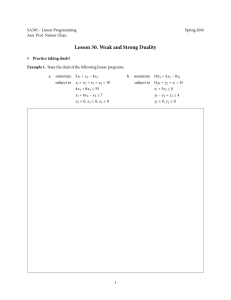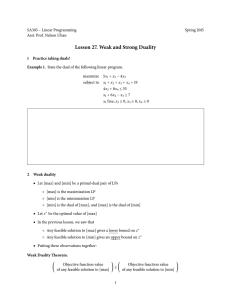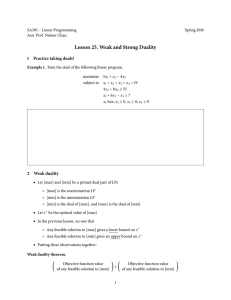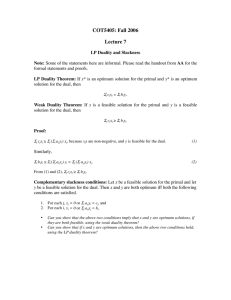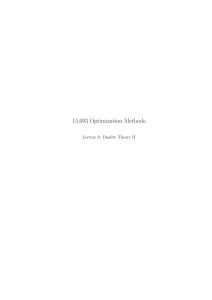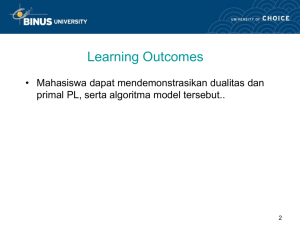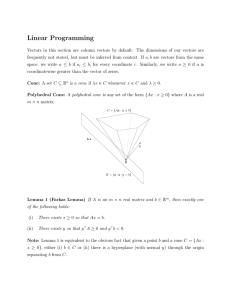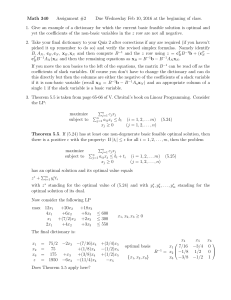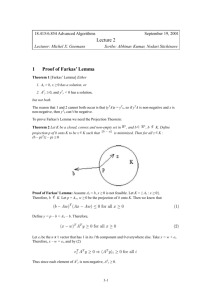Lesson 30. Weak and Strong Duality
advertisement
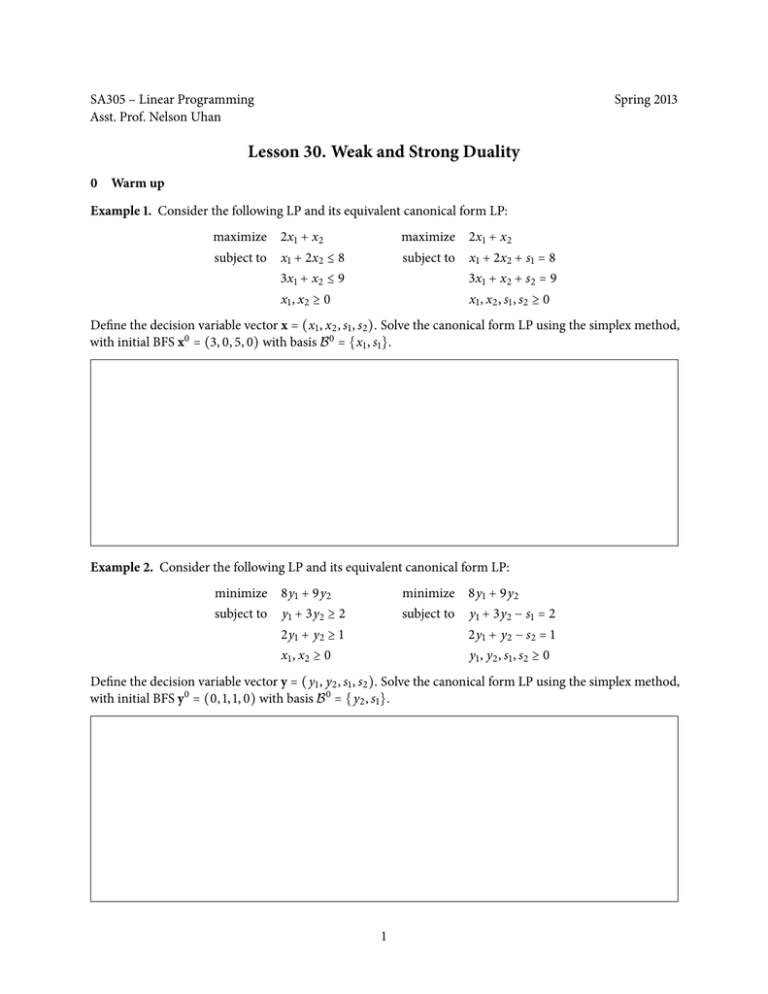
SA305 – Linear Programming
Asst. Prof. Nelson Uhan
Spring 2013
Lesson 30. Weak and Strong Duality
0
Warm up
Example 1. Consider the following LP and its equivalent canonical form LP:
maximize
2x1 + x2
maximize
2x1 + x2
subject to
x1 + 2x2 ≤ 8
subject to
x1 + 2x2 + s1 = 8
3x1 + x2 ≤ 9
3x1 + x2 + s2 = 9
x1 , x2 ≥ 0
x1 , x2 , s1 , s2 ≥ 0
Define the decision variable vector x = (x1 , x2 , s1 , s2 ). Solve the canonical form LP using the simplex method,
with initial BFS x0 = (3, 0, 5, 0) with basis B 0 = {x1 , s1 }.
Example 2. Consider the following LP and its equivalent canonical form LP:
minimize
8y1 + 9y2
minimize
8y1 + 9y2
subject to
y1 + 3y2 ≥ 2
subject to
y1 + 3y2 − s1 = 2
2y1 + y2 ≥ 1
2y1 + y2 − s2 = 1
x1 , x2 ≥ 0
y1 , y2 , s1 , s2 ≥ 0
Define the decision variable vector y = (y1 , y2 , s1 , s2 ). Solve the canonical form LP using the simplex method,
with initial BFS y0 = (0, 1, 1, 0) with basis B 0 = {y2 , s1 }.
1
1
Weak duality
● Consider the following primal-dual pair of LPs
[P]
maximize c⊺ x
subject to
[D]
Ax ≤ b
minimize b⊺ y
subject to
x≥0
A⊺ y ≥ c
y≥0
● Remember we constructed the dual in such a way that the multipliers y give us an upper bound on the
optimal value of [P]
Weak Duality Theorem. Let x∗ be a feasible solution to [P], and let y∗ be a feasible solution to [D]. Then
c⊺ x∗ ≤ b⊺ y∗
Corollary 1. If x∗ is a feasible solution to [P], y∗ is a feasible solution to [D], and
c⊺ x∗ = b⊺ y∗
then (i) x∗ is an optimal solution to [P] and (ii) y∗ is an optimal solution to [D].
2
Corollary 2. If [P] is unbounded, then [D] must be infeasible.
Corollary 3. If [D] is unbounded, then [P] must be infeasible.
Proof. Similar to the previous corollary.
● Note that primal infeasibility does not imply dual unboundedness
● It is possible that both primal and dual LPs are infeasible
○ See Rader p. 328 for an example
● All these theorems and corollaries apply to arbitrary primal-dual LP pairs, not just the ones we specified
above
2
Strong duality
Strong Duality Theorem. Let [P] denote a primal LP and [D] its dual.
a. If [P] has a finite optimal solution, then [D] also has a finite optimal solution with the same objective
function value.
b. If [P] and [D] both have feasible solutions, then
● [P] has a finite optimal solution x∗ ;
● [D] has a finite optimal solution y∗ ;
● the optimal values of [P] and [D] are equal.
● This is an AMAZING fact
● Useful from theoretical, algorithmic, and modeling perspectives
● Even the simplex method implicitly uses duality: the reduced costs are essentially dual solutions that
are infeasible until the last step
3
